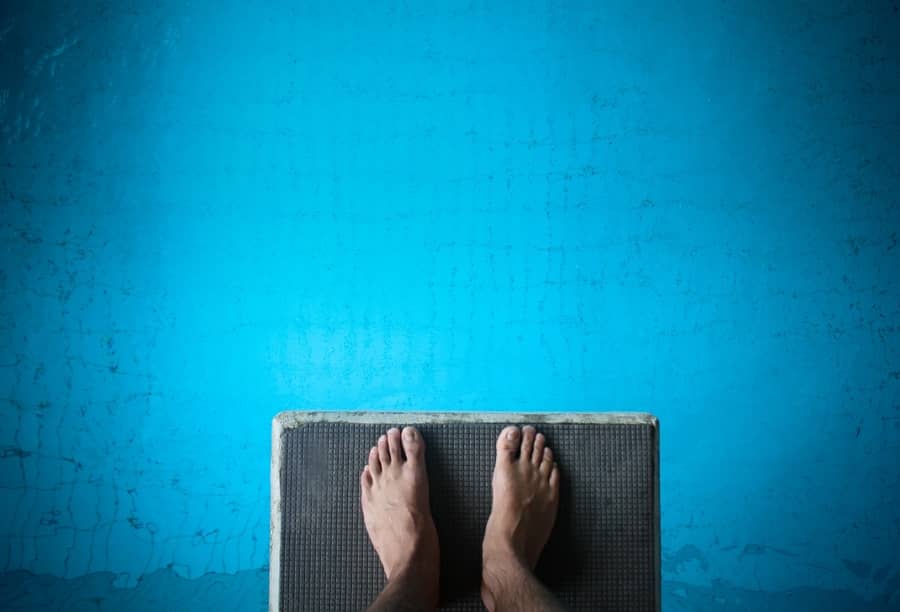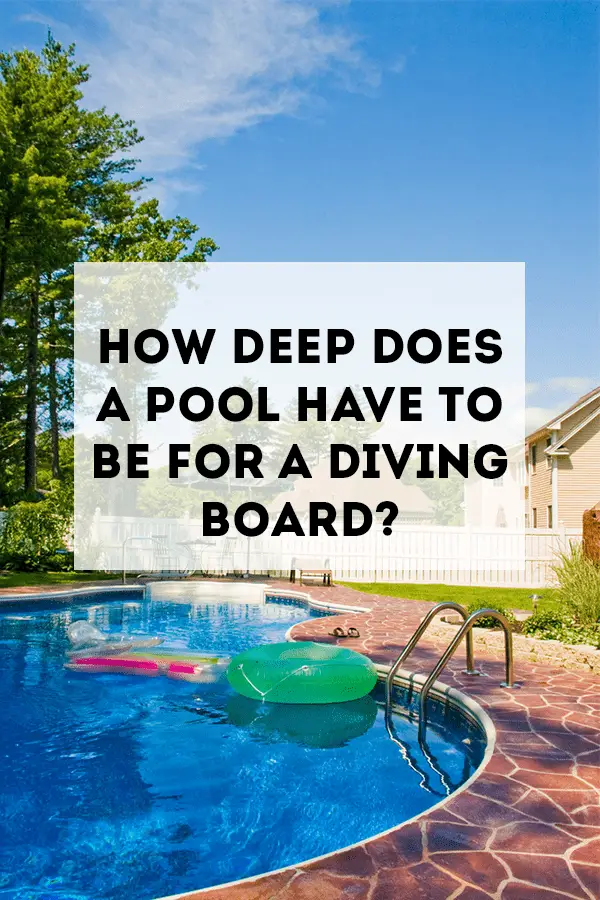
Do you own a pool in your yard? Or better yet, have you experienced the exhilarating effect of swimming before? If your answer to any of those questions is YES, then you will certainly agree with me that swimming pool is indeed an enjoyable recreation source. Though we need not stress the fact that pools are also used for other bathing activities aside from its recreation purpose; activities like: wading, playing, water exercising, competitive swimming, to name a few. The truth is: with an installed diving board, the fun of using a swimming pool can increase. However, before adding a diving board to your swimming pool, the depth of the water needed to be taken into serious consideration.
How deep does a pool have to be for a diving board? Basically, for a swimming pool to have a diving board, it must be at least nine feet deep. Although, the depth of pool used in competition is much deeper (due to some factors) varying from twelve feet to eighteen feet. So, typically a pool that has a diving board requires at least a nine feet to twelve feet deep end.
Granted, rather than focusing or worrying about the depth of your swimming pool, it would be more advantageous to put into consideration factors that would help you in narrowing-down your depth choice. Take for instance, if your concern primarily is of children, a pool of three feet would be okay because this would afford the children the avenue to learn how to swim. Also, while adults need a three and half feet or deeper pool for swimming without hitting feet or hands on the bottom (a depth for mainly relaxation purposes), if you are looking for a pool to jump in feet first, a depth of four feet would be the minimum requirement.
On the other hand, diving in headfirst requires a pool depth of at least nine feet (2.7m). Nine feet! Why such a stark difference in depth? Why must it be that deep?
Structural Concern
Put simply, when you jump into the pool headfirst, you hit the water with greater gravitational force, hence, your body thus has the potential to travel to a greater depth. According to the American Red Cross, most diving injuries happen in less than five feet of water. So, it is of paramount importance for a diving pool to be deep because if not taken into consideration it can lead to potential head injuries or paralysis. Of course, the type of the diving board used goes a long way in determining how deep the pool needs to be. Basically, there are two types of diving board namely:
1. Spring board: a board that is itself a spring (usually adjustable up to 3m high) used for diving.
2. Diving Platform: a type of structure (usually fixed platform up to 10m high) used for competitive diving mostly use in Olympic competitions.
No wonder, According to FINA [the international governing body for World Championship and the Olympics] the minimum pool depths based on the height of the diving board is as follows:
1m diving board = 11.5ft pool depth
3m diving board = 12.5ft pool depth
1m diving platform = 11ft pool depth
3m diving platform = 12ft pool depth
5m diving platform = 12.5ft pool depth
7.5m diving platform = 15ft pool depth
10m diving platform = 16.5ft pool depth
Other Concerns
If you are one of those people who plan of installing a diving board, then you must be concerned not only about the depth of your pool but also the width of the swimming pool, because you will not only need a deeper pool, but also a wider one in order for people not to accidentally dive into a wall. As a matter of fact, the minimum size for a pool with diving board installed may be a matter of law in your community.
To illustrate, the average swimming pool length ranges from thirty feet to forty feet; also the average shallow end is about three and half feet deep; now going from a shallow end at three and half feet to the deep end at nine feet over such a small distance of length of course would definitely create a very steep downward slope, which can also become very slippery. This is very dangerous for anyone who is not good at swimming, most especially children and elderly. The longer the length of your swimming pool, the safer it is for diving.
Another factor to consider when deciding if you will be installing a diving board is what we will call the diving envelope. In fact, it is the most important aspect of choosing the right diving board. A diving envelope is the area in which a diver could enter the water, and the depth and distance they could travel when diving. In order words, a diving envelope is the water found in front of, below and on each side of a diving board. This area must contain enough water to ensure the safety of the diver. An appropriate diving envelope will depend on the size, shape and construction of the swimming pool.
It’s very important to ensure that there is not only enough depth directly beneath the diving board, but that the pool floor doesn’t begin to rise too near the diving area. The importance of the diving envelope cannot be overly emphasized, if you will be installing a diving board in your pool, your responsibility goes beyond choosing the right kind of diving board, it entails ensuring the safety of everyone who uses your swimming pool. Or what benefit would you get from installing a diving board that is too long for your pool, which could make a diver break or injure their hands, arms, shoulders, knees, head, or neck. Always remember, Injuries sustained from improper diving can cause lifelong paralysis or even death.
Admittedly, diving board comes with high risk, but of course the fun outweighs the risk. Just think of it: what in life does not have a measure of risk? Life itself is risky. Sadly, many individual alludes to the risk involved in diving as the reason why most swimming pools doesn’t have an installed diving board. The stats are discouraging. Gone are those days when 9 out of 10 swimming pools that were installed had diving boards, the passage of time has taken its toll on the popularity of diving board. The popularity has waned with time. Nowadays, hardly do we see 1 in 4 swimming pools with installed diving board. Should you be swayed by the majority view or should you consider installing diving board in your swimming pool? Consider the fact.
Taking an Holistic View
Granted, the issue of safety concern is the major reason why some pool professional express their concern, which of course is legitimate, for diving board. Yes, diving accident do happen but this is in rare occasion though serious cases. Often time this happen amidst tall divers or those who might have been intoxicated and took a wild jumps off the board. While this concern is noted, some professional admit that diving board offers a lot of advantages when it comes to safety measure. According to the Spinal Cord Injury Information Network and the University of Alabama at Birmingham, less than 10 percent of all swimming pool diving injuries involve a diving board.
Also, diving board could also enhance safety in that it serves as one of the surest
It is nothing but the truth that diving boards can provide you and your children with hours of fun in your backyard or community swimming pool. It also serves as an enjoyable recreational feature on backyard pools. You can enjoy this wonderful feature with your family the next time you visit your community pool or you could even incorporate it with your plans if you’re thinking of having one in your yard, just ensure that any pool you or your loved ones will be using is no less than nine feet deep.
Related Questions
Should you dive in an above-ground pool?
No. Diving boards should never be allowed on above ground pools.
What pool shape is best for diving?
Though, most residential pools come in two general shapes, namely: the spoon-shaped pool and the hopper-bottomed pool. The pool’s sides wall of a hopper-bottomed pool is sloppy, thus creating a type of funnel when a diver enters the pool. This restricts the part of the pool with a safe diving envelope, though the water looks deep enough. As for the spoon-shaped pool, it has a larger diving envelope, but there is less distance from the end of the diving board to the bottom of the pool thus making the water appearing deeper than it is.


